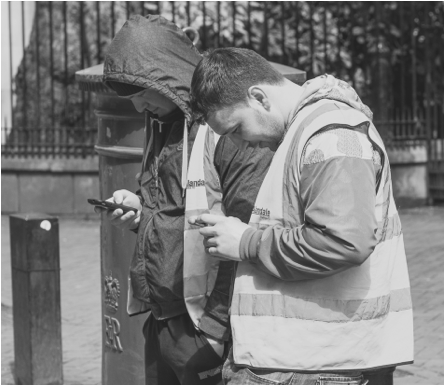The world is more talkative now than at any time in its history, but this is increasingly at the expense of meaningful conversation. We are talking at rather than to each other, at least that’s the view of Sherry Turkle, a Professor at MIT’s Media Lab and author of the book Alone Together. Mobile devices, especially smart-phones, have invaded formerly quiet and/or private spaces and we appear to be spending more time looking downward (at screens) that outward (at each other or our environment). Friendship, even love, are being mediated through screens and the real world is increasingly being looked at second-hand and through filters.
In an article in the Huffington Post, the photographer Babycakes Romero points out that there is “symmetry” to individuals on mobile devices and that couples and even groups are: “locked simultaneously yet separately into the same action.” He also comments upon the: “sadness to the proceedings”. Some individuals remove themselves further, wearing headphones to cut out auditory distractions or virtual reality headsets to remove other people altogether.
To some extent we are now using smartphones and other devices much in the same way that we used to use cigarettes, to pass the time or to hide our social awkwardness, but perhaps it is the devices themselves that are causing this awkwardness. You might argue that in a culture dominated by individuals and personalization there is less common culture to talk about, or perhaps we are using our devices to hide our fundamental loneliness or insecurity. Hence our endless quest for validation and approval.
Our devices are certainly inducing silence, although we have simultaneously become less able to deal with it. We have lost, or we are losing, both the ability and the desire to be alone. Hence, mobile devices are providing an excise for people, especially couples, to withdraw rather than engage in conversation and to keep the world (and each other) at a controllable distance.
Whether or not there is an emerging etiquette regarding mobile device use is uncertain.
A few years ago the answer would have been no. But now some people are beginning to understand that the use of certain devices in certain situations is either rude or awkward. But these people remain an exception. Even using phones during funerals (“RIP, innit”) is not quite as frowned upon as it once was.
Another of Babycake Romero’s observations is that when people are engaged with a mobile device they don’t seem mentally present and are not enjoying the moment or other person for what it or they are. This is especially apparent in restaurants where the “dining dead” (his phrase) can hardly look at each other, such is the pull of the prospect of incoming information.
Clearly what we are really saying here is that I like you, but that you could be trumped at any moment by something or someone else. This can hardly be good for our self-esteem so, in an ironic twist, we are more likely to turn to our mobile devices and cyberspace to satisfy our hunger for connection. An endless cycle of disconnection and connection.
A final, but important, point is that when we do present ourselves through mobile devices (and social media in particular) our identity is contrived. It is rarely the real us. Instead we use a fake identity that is consciously manipulated and manicured. Through our screens we appear happier, more optimistic and more successful than we really are. The nature of these on-screen conversations also favours showmanship and extroversion.
The end result is that our connections are partly based upon false information, but also that we end up believing our own false PR. This situation can endure for a long time, but at some point we will be inevitably be mugged by reality.
Images: Copyright Babycakes Romero (with thanks)
References: Huffington Post (UK), 27 October 2014, ‘Photographer Babycakes Romero caputures the death of dining’ due to smartphones’ (P. Bell). See also ‘The flight from conversation’ by S. Turkle, New York Times (US) 21 April 2012. and ‘Saving the lost art of conversation’ by M. Garber, Atlantic Monthly (US) January 2014.



Dopamine junkies zombified by info overload -which ultimately becomes noise, rather than signal.
I do worry!
Nice to have you back. What have you been up to? Every time I listen to the shipping forecast I imagine you looking out over windswept grassland….
Yeah snowed under with work & weather both!
Little grassland:
http://glebedigital.tumblr.com/image/109491606925